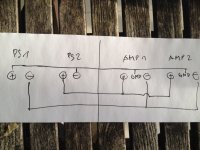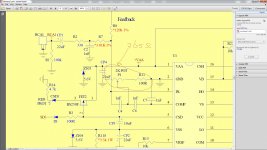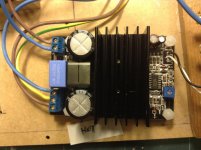If I remember correctly, your supply is +/- 50V @ 3 amps. That is already too small for 1 amp, let alone two.q
quick update: got the SMPS today and hooked up the two amps.. both work !! i was expecting one to have burnt out during my "test" phase but no, it works.
They sound surprisingly good as well. A little weak un the bass department compared to a Pioneer A-717. Next, Ill put the amps into a chassis with some nice wires because I think they merit it. Considering the test layout (photo) they are very quiet as well.
Sent from my iPad using Tapatalk
They sound surprisingly good as well. A little weak un the bass department compared to a Pioneer A-717. Next, Ill put the amps into a chassis with some nice wires because I think they merit it. Considering the test layout (photo) they are very quiet as well.
An externally hosted image should be here but it was not working when we last tested it.
Sent from my iPad using Tapatalk
Last edited:
The irs2092 is a good little IC.
I have built numerous circuits with the irs2092.
From mono 300 watts up to stereo 800+800 watts.
I have built numerous circuits with the irs2092.
From mono 300 watts up to stereo 800+800 watts.
yes indeed. i'm currently comparing them to a whopping huge Pioneer amp which is probably not fear but i must say that they hold up quite well. As stated, a little more bass thump would be perfect and maybe doable through a tweak or two but i cant find any documentation / diagrams on this particular module
Sent from my iPad using Tapatalk
Sent from my iPad using Tapatalk
ok, after a couple of hours of low volume listening, one of the two amps is getting very hot. So maybe it did suffer some damage from my "testing". Any ideas what could be causing the overheating ?
Sent from my iPad using Tapatalk
Sent from my iPad using Tapatalk
ok, after a couple of hours of low volume listening, one of the two amps is getting very hot. So maybe it did suffer some damage from my "testing". Any ideas what could be causing the overheating ?
Sent from my iPad using Tapatalk
Could be that the blue potmeter is adjusting the oscillator frequency of the amp and it is set to low . See if it changes if you adjust it . value of the pot should be something like 2 kOhm . If you don't have a scope , just try to give it the approx . same setting as the board that doesn't get hot .Ideal it should be around 400 kHz with no signal and input shorted ( mostly around 265 ohms measured over the pot and series resistor , if there is one )
Cheers ,
Rens
Attachments
Do both heatsinks get hot ?
no, only the one of the two (the one on the left in the pic)
Sent from my iPad using Tapatalk
Could be that the blue potmeter is adjusting the oscillator frequency of the amp and it is set to low . See if it changes if you adjust it . value of the pot should be something like 2 kOhm . If you don't have a scope , just try to give it the approx . same setting as the board that doesn't get hot .Ideal it should be around 400 kHz with no signal and input shorted ( mostly around 265 ohms measured over the pot and series resistor , if there is one )
Cheers ,
Rens
that could be it... will give it a try and report back [emoji57]
Sent from my iPad using Tapatalk
heat issu
i have pinpointed the heatsource to the gray component between the two caps (it looks like some kind of relay) .. it gets so hot that i cannot hold my finger on it for lomger than a second before it gets painful. The heat then spreads to the caps and on to the rest of the board. Anyone know what this component is and if it is fixable ?
thanks !
i have pinpointed the heatsource to the gray component between the two caps (it looks like some kind of relay) .. it gets so hot that i cannot hold my finger on it for lomger than a second before it gets painful. The heat then spreads to the caps and on to the rest of the board. Anyone know what this component is and if it is fixable ?
thanks !
Attachments
sorry,these cheapo amps have no schematics... is this related to what doctordata was mentioning ? i have no measuring equipment exept a multimeter so i tried to adjust the pot to aprox the same position as the second amp with no noticable effect
btw there seems to be a coil in the gray component so you are probably right
The heat in the output inductor is caused by a low oscillator frequency .
Use your ohmmeter to adjust the total resistance as I mentioned earlier to approx. 265 ohms . You can measure the resistance in circuit ( powered down of course )
Cheers ,
Rens
- Status
- Not open for further replies.
- Home
- Amplifiers
- Class D
- IRS2092 Class-D Mono Amplifier Board


